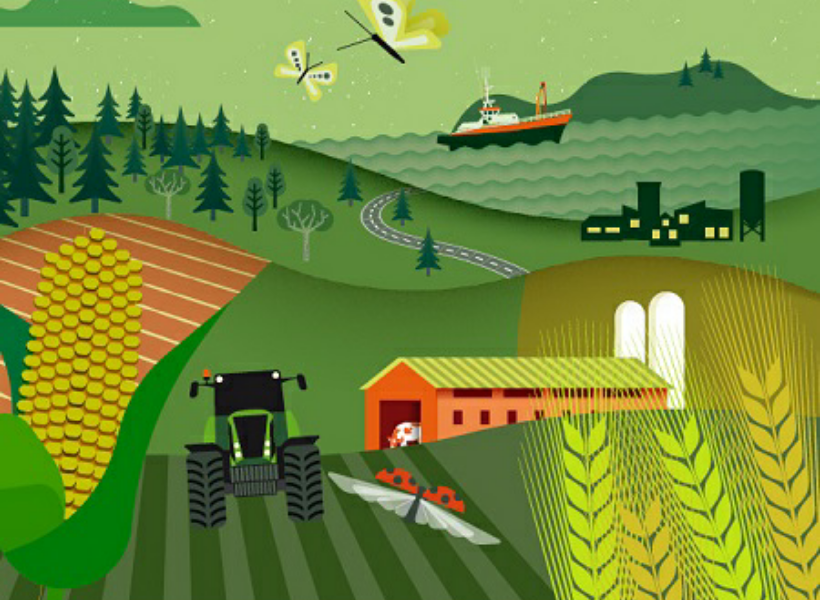The production of oil and gas has brought many countries considerable wealth. At the same time, it has made many of them such as Nigeria, Angola, and much closer to home, Trinidad and Tobago, dangerously vulnerable to external shocks and dependent on export revenue. Taking this into account, experts far and wide have cautioned Guyana to diversify; to avoid neglecting the development of its agriculture sector, even as it swims in 9 billion barrels of oil equivalent resources.
But since the discovery of oil resources in 2015, what did the coalition administration do from a budgetary perspective to ensure that the agriculture sector, a critical contributor of the non-oil economy, is poised for continued growth? What plans, policies and investments were set forth to ensure the sector progressed to a position of being an even greater revenue contributor to the nation’s purse?
To answer these questions, Guyana Standard embarked on an examination of the budgets presented by former Finance Minister, Winston Jordan from 2015 to 2019. The results were then compared against the latest budget of Senior Minister of Finance within the Office of the President, Dr. Ashni Singh.
Immediately, there were two crucial findings: 1) Pound for Pound, the PPP is seeking to do more for the agriculture sector with one budget than the coalition did in five years; and 2) During the time of the APNU+AFC faction, there was a noticeable decline in the allocations for the agriculture sector under the coalition.
It should be noted that Guyana Standard is not in any way stating that the coalition’s budgets were ineffective or what it had allocated for the agriculture sector was irrational. The analysis was done to examine the extent to which the agricultural sector was being prepared to continue its longstanding role as a revenue and development contributor in the face of Guyana’s new status as an oil-producing state.
That said, we will now provide a summary of our examination of the budgets presented by Mr. Jordan.
BUDGET 2015
Coming into office in May 2015, Jordan was forced to quickly hold consultations with industry stakeholders and craft the budget which was presented on August 10 in the National Assembly. Many argued that Jordan at the time did not have the luxury of being able to properly planning for the year and was forced to work with what he inherited from the PPP/C administration.
Taking this into consideration, he was not heavily criticized when his maiden budget–in which policies and leading projects were absent for the sector–just noted that $25.5B was allocated to support further payments to rice farmers and other stakeholders within the sector while, $8.2B has been allocated to support the sugar industry.
During his presentation, Jordan had announced that the coalition government would ensure that the Agriculture Disaster Management Plan, a PPP/C initiative that was launched in 2013, would be implemented. He said that this would see the enhancement of the Hydrometeorological Early Warning Systems (EWS), in order to ensure proactive mitigation, preparedness and responses on behalf of the farmers. A package of climate-smart agriculture methods and technologies was also budgeted for and promoted that year.
Further to this, the economist noted that government in 2015 would commit to restoring and enhancing soil fertility, crop rotations, efficiency in water use, reduction in the use of chemicals, pesticides and herbicides, and reducing food spoilage and loss by expanding the use of post-harvest storage and processing facilities. Noting that the use of bagasse for cogeneration of electricity is a noteworthy example within the sector, Jordan said that the Government would encourage expanded use of green technologies, going forward.
BUDGET 2016
In his 2016 budget, Jordan had allocated $20.3 billion to “the agricultural sector to create an economic environment in which farming and agro-processing operations can grow the economy and create employment.
Apart from this, the 20.3B was dedicated to:
-enhancing diversified agriculture in the hinterland, riverain communities and the intermediate and Rupununi savannahs.
-Supporting the Guyana Sugar Corporation with bailouts
-Develop 4,000 acres of state lands, situated in Region 9, for the purpose of constructing an agriculture station. (This station would go on to serve as a pilot for the sustainable harvesting of surface water for agriculture in this region.)
Jordan also noted that there would be an increased focus in the fisheries sector with the promotion of the sustainability of the marine fishery resources through continued efforts to attain Marine Stewardship Certification for the sea bob subsector. This was achieved in 2019.
BUDGET 2017
In 2017, the former Finance Minister gave the agricultural sector $300M increase over the previous year, taking it to $20.6B.
In this budget, he repeated his 2016 goal of enhancing diversified agriculture in the hinterland, riverain communities and the intermediate and Rupununi savannahs.
In the 2017 budget, this was worded as, “We will begin to responsibly open the vast Intermediate and Rupununi Savannahs and the arable lands for large agricultural plantations, with a focus on applications for agro-processing and agro-industries. We will explore options for non-traditional agricultural crops, such as corn, spices, and quinoa.”(This was not done!)
BUDGET 2018
In 2018, the former Finance Minister gave more definition to his plans for the sector but dropped allocation from $20.6B to $19.4 billion.
In 2018, Jordan had articulated that the Special Purposes Unit (SPU) attached to the National Industrial and Commercial Investments Limited (NICIL) would be responsible for divesting the Skeldon, Rosehall, and East Demerara estates. Jordan, and by extension, the rest of the coalition government, had reasoned that the shutting down of these estates was necessary since “our taxpayers must no longer be burdened to carry the weight of an unprofitable, inefficient, and antiquated public corporation.”
As it relates to the rice industry, Jordan had said that the government would partner with the Islamic Development Bank (IsDB), through the Malaysia Agricultural Research and Development Institute (MARDI), in updating the expertise and technology in rice production, through a Reverse Linkage Project to the tune of US$863,000.
Additionally, Jordan had ensured an allocation of $265M for an agricultural centre and reservoir in Lethem, along with the upgrading of the agricultural research station in Ebini. (This was not done)
The economist had also earmarked money for two modern abattoirs for Regions No. 5 and No. 9. (This was not done.)
Jordan had said too that work would commence, in 2018, on the development of aquaculture and inland fisheries regulations along with the finalization of the marine fisheries regulations. This, unfortunately, did not materialize.
In 2018 as well Jordan reminded again of his plan to expand agricultural activities in the hinterland region. In this regard, the former Finance Minister announced that the coalition would take stock of the current configuration of farmers, farming systems and cost structures across the country, through a national agricultural census that would cost $200 million. He had said, “The census will also complement our interventions, especially as we escalate our attention and investment in the Intermediate and Rupununi Savannahs.”
BUDGET 2019
For 2019 the coalition government had allocated approximately $18B for the sector which was more than a $1B drop from the previous year’s allocation.
With respect to the agriculture sector, Jordan had noted that Guyana signed an agreement with the premier Malaysian Agricultural Research and Development Institute to support enhanced productivity in our rice industry. This would see three new high-yielding, pest-resistant and disease resistant varieties (one of which is an aromatic variety) being tested for production in Guyana, with an expected increase in yield of 5 percent per annum, over the next three years.
He said that in addition to the foregoing, there would be a new abattoir but this time at Onverwagt, West Coast Berbice. This initiative was being pursued to reduce importation. Discussions were also expected to start with the Islamic Development Bank to create a reverse linkage project in livestock and Halaal meat.
For 2019 as well, Jordan “envisioned” conducting a feasibility study to establish a dairy value chain, through the supply of improved breeding stock to farmers, milk chilling stations, and refrigerated trucks to supply fresh milk to a new milk plant to be built not by the government at Diamond, East Bank Demerara, but by a leading Guyanese firm.
Jordan had also repeated his “desires” to have an agriculture census conducted.
BUDGET 2020/ 2021
After passing the 2020 emergency budget, Finance Minister, Dr. Ashni Singh had ample time to prepare the 2021 budget. Many expected that with Guyana being an established producer for one year, most of the budget’s attention might have centered on the numerous regulatory and legislative areas that need urgent improvement. Though some issues were highlighted, Dr. Singh’s extensive articulation on the agriculture sector shows that the PPP/C has every intention of ensuring the industry is anchored in a position that allows it to play a key role in the country’s economic advancement.
To ensure the sector is able to discharge its envisaged role, Dr. Singh noted that the Government will invest in: opening new farm-to-market roads; clearing and preparation of new lands; expanding the infrastructure in the intermediate savannahs; expanding drainage and irrigation networks to make new land available for small, medium, and mega farms; strengthen extension services through additional and improved facilities; traceability and certification services to reduce existing trade barriers; research and development; and coordinating and facilitating private sector participation in agriculture-based tourism.
To ensure this is done, he said that expenditure in the agriculture sector is expected to increase to $22.6 billion from $18.3 billion in 2020.
With respect to sugar, the Minister said that a detailed diagnostic of the industry is underway in order to make it fit for purpose for sugar and value-added opportunities including diversification into non-traditional areas. In fact, work is currently ongoing on developing a master plan, estate by estate, to guide the future of the industry.
On the matter of the three estates that were closed by the APNU/AFC Government, the PPP/C administration he said is currently assessing the damages and the cost to rehabilitate these estates to make them profitable cost centres, including but not limited to introducing public-private partnerships, agro-industrial and agro-energy opportunities, and pursuing product diversification, and retraining where necessary.
Guyana Standard would have reported that budget 2021 provides an allocation of $2 billion for critical capital works at GUYSUCO.
With respect to the rice sector, Dr. Singh disclosed that steps were taken to ease the farmers from the burdensome overhead expenses imposed on them, by reversing the increases in land rents and taxes on agricultural equipment, machinery, fertilizers, and chemicals. For instance, the rice farmers under the Mahaica/Mahaicony/Abary – Agricultural Development Authority will now see about $1.3 billion back in their hands annually with the reversal of land rent increases.
By 2024, Dr. Singh said that the government expects a dramatic increase in annual rice production over the next five years, ensuring that the crop remains a mainstay in our agriculture output. Further to this, he said that the increase will be propelled by enhanced research and development; adoption of new technologies and promotion of new high yielding varieties; increased maintenance of drainage and irrigation systems and farm-to-market roads; and establishment of new markets.
In 2021, Dr. Singh said that citizens can expect to see six drying floors being constructed at strategic rice-producing locations to provide much-needed support to farmers in Regions 2, 3, 5 and 6, while adding that a soil laboratory will be established to facilitate efficient and economic production of paddy.
Additionally: five long reach sprayers will be acquired to control paddy bugs on dams and fields efficiently; a motorized thresher will be purchased to aid in plant breeding experiments; a laboratory will be constructed for experimental trials on value-added rice products; a Post-Harvest/Value-Added Department will be Page 29 of 77 established at the Guyana Rice Development Board (GRDB); and physical and sensory analyses will be pursued for shelf-life studies for rice and rice-based food products.
The Minister said that these initial steps will position the rice industry to gain the momentum needed to achieve the targeted growth in the medium-term.
In light of the fact that coconut is the new frontier crop of the sector and is expected to take off over the medium term, Dr. Singh disclosed that this administration will fund the establishment of four new coconut nurseries at Wakenaam, Leguan, Canal No. 2 and No. 63 Village in Corentyne which will each produce 1,500 to 3,000 coconut seedlings, every three months.
As such, farmers can benefit from high-quality planting material at an affordable cost. Further, the Minister said that technical training on inter-cropping and cultivation will be provided to coconut farmers to help them optimize their returns on investments. Support from the government will also see the private sector investing in over 1,000 acres of coconut estates, in the near term. In this regard, Budget 2021 provides over $70 million to support Hope Coconut Estate Ltd.
With regard to corn and soya bean, both of which represent a major new frontier in the other crops sector, Dr. Singh noted that the Government will cultivate 100 acres of planting material to support the production of corn and will make it available to farmers at affordable prices. This is intended to reduce the importation of this commodity and will augment the plans for large scale corn and soya bean cultivation expected under the Intermediate Savannah Development Initiative (ISDI) discussed below.
In relation to agro-processing, Government is expected to invest $832 million in agricultural infrastructure including agro-processing and packaging facilities. These interventions will be done in Lesbeholden, Parika, Sophia, St. Ignatius, Aranaputa, Kara Kara and the Intermediate Savannahs.
The Finance Minister said too that the Government will also be taking steps to strengthen the cold-storage capacity for seasonal produce destined for exportation and agro-processing. In this regard, two freezer trucks and two 40-foot refrigerated containers will be procured at a cost of $60 million for the New Guyana Marketing Corporation (GMC).
With respect to livestock, Dr. Singh said that the Government will facilitate the establishment of processing facilities, develop certification processes and pursue access to regional and international markets for local producers. Moreover, Government will support investors by developing livestock traceability capacity to improve the accuracy and reliability of data, which is fundamental to meeting food safety standards and farm certification and will help to promote exports. To support these initiatives, $806 million will be provided to the Guyana Livestock Development Authority in 2021.
In the area of Fisheries and Aquaculture, Dr. Singh had said that the Government is keen to revitalize the fishing industry and has reversed increases in licensing fees, removed taxes on fishing equipment, and allowed fish exporters to reclaim VAT on inputs to production. Over the medium-term, he said that the Government will focus on supporting the development of inland fisheries and aquaculture through amendments to the Aquaculture and Inland Fisheries Regulations, finalize a Strategic Plan for the subsector, and develop guidelines for sustainable aquaculture and ornamental industry in Guyana, among other initiatives.
Guyana Standard during its assessment also noted that the PPP/C Administration intends to launch an Intermediate Savannah Development Initiative to support the production of both crops and livestock. In Budget 2021, $500 million will be invested in supportive infrastructure to catalyze private investment in the production of corn and soya via the initiative.
In 2021, Dr. Singh said that the government will invest $12 billion in critical interventions across the country. These include: construction and rehabilitation of pump stations at Adventure, Black Bush Polder, Cottage, and Montrose, supporting over 54,000 acres of coastal farm lands; procurement of two excavators and a pontoon to desilt channels in the Pomeroon river, facilitating improved access to farms; and development of water harvesting mechanisms to support farms in the South Central Rupununi, alleviating the significant losses incurred in the dry season. These interventions will result in a reduction of vulnerability and flood risks by promoting climate resilience. The reduction of risk and losses will encourage increased production of rice, coconut, vegetables, fruits, and livestock in these areas.











